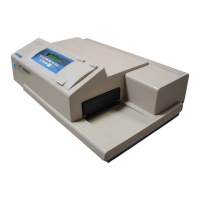Principles of Operation
28 0112-0115 F
Fluorescence Polarization (M5 and M5
e
only)
By using a fluorescent dye to label a small molecule, its binding to a
large molecule can be monitored through its speed of rotation.
Fluorescence Polarization mode returns two sets of data: one for
fluorescence intensity parallel (P) to the excitation plane, and the other
for fluorescence intensity perpendicular (S) to the excitation plane.
These S and P values are used to calculate the polarization (mP) and
anisotropy (r) values in SoftMax Pro Software. Although the Raw S&P
value is the true raw data returned from the instrument, the calculated
polarization (mP) and anisotropy (r) values are treated as the raw data,
and these values become the basis for further reduction calculations in
SoftMax Pro Software.
Polarization (mP) is calculated as follows:
Anisotropy (r) is calculated as follows:
Luminescence
Luminescence is the emission of light by processes that derive energy
from essentially non-thermal changes, the motion of subatomic
particles, or the excitation of an atomic system by radiation.
When the SpectraMax Multi-Mode Microplate Reader is in luminescence
mode, no excitation is necessary as the species being measured emit
light naturally. For this reason, the lamp does not flash, so no
background interference occurs. A dark estimate is done over a dark
reference, and multiple readings are averaged together into one
reading per well.
The default setting for luminescence is the “zero order” position where
the grating monochromator acts as a mirror that reflects all light to the
PMT detector. If wavelength selection is desired, you can choose the
wavelength where peak emission is expected to occur. In addition,
multiple wavelength choices allow species with multiple components to
be differentiated and measured easily. In luminescence read mode, no
emission cutoff filter is used.
mP
parallel G perpendicular–
parallel G perpendicular+
------------------------------------------------------------------------=
r
parallel G perpendicular–
parallel 2G perpendicular+
----------------------------------------------------------------------------=

